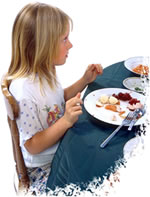 |
||||||
 |
 |
 |
||||
|
Article Credit: SaferChild.org
Remember the Food Pyramid and the Five Food Groups? They're still important. You must eat every day from the five food groups: grains, vegetables, fruit, meat or other protein, and dairy products. Many families are too light on fruit and vegetables, but nutritional experts say that everyone needs 5 servings a day of fruit and vegetables. Juices aren't a good substitute -- they're too high in calories and sugar and too low in nutrients and fiber. You can serve fruits and vegetables (not just potatoes!!) as finger food, with dips, cooked in meals, mixed in yogurt, on top of cereal, in soups, on sandwiches, on pizza, in casserole dishes. Turn dinner into a salad bar. Turn it into a picnic. Mix it up and try different ones. Eat fruits and vegetables with every meal, and be willing to try new ones. Don't make dessert a part of every dinner: Dessert should be a special item. Making it a regular part of dinner might cause a child to eat less dinner in expectation of getting dessert. Dessert also should be contingent on the consumption of a well-balanced meal. Don't ban foods from the house: This only makes them more tempting. Keep them in a special cupboard or drawer for special occasions. Don't lock them up, however, or turn them into a big deal. Don't call them "bad stuff" or "temptations." Don't berate yourself for "giving into temptation." They're just food, like other types of food, except that they're meant to be eaten in small doses. Don't focus on a specific target weight: People come in all shapes and sizes. Instead, talk about getting strong, healthy and more energetic. Limit fast food to occasional treats: Restaurant portions tend to be much larger than one person needs -- sometimes five times as much. Fast-food restaurants try to make it sound like a deal to "super size," but this is no deal for your body. Plus, restaurant foods tend to be high in sugar, fat and salt. Make eating at home -- around the dinner table and with the television off -- a habit in your home, and make fruits and/or vegetables a part of every meal. Don't allow cereal to make up any meal other than breakfast. Also watch those already-prepared foods. Besides being more expensive, they also tend to be higher in fat and salt. Want a quick and easy way to make nutritious meals? Buy a slow cooker and use it regularly. Try to avoid the processed, fat or sugar-filled and "quick" foods: Popular foods that are high in fat, salt, sugar and empty calories include these: soft drinks, sugar drinks and "juices" that aren't 100 percent juice; prepackaged lunches and snacks; hot dogs; french fries; baked goods such as doughnuts, toaster pastries and cookies; fried foods such as chicken nuggets and fish and chips; bagged snacks such as potato chips, taco chips, snack mixes and crackers; supposedly "healthy" snacks such as snack bars, high-fat granola, and fruit leather. Don't assume that a low-fat diet will help you lose excess weight: Unless you're eating mostly whole grains, fruits, vegetables and low-fat or skim milk, a low-fat diet may do nothing for you except put on weight. Many processed fat-free or low-fat foods are high in sugars, and thus high in calories. They also tend to be extremely high in salt content. Weight loss or weight gain is measured in the total number of calories consumed versus the total number expended. Consult your pediatrician/doctor for help in putting together a healthy menu for yourself. Limit soda and juice: Eating fruit is much better than drinking fruit juice, and sodas are not only full of sugar and useless calories -- they're also dehydrators. Water, sports drinks and milk are better choices. If you drink juice, however, try to make sure it's 100 percent juice, not just 100 percent Vitamin C. To read more helpful tips from this article, read: |
|
© ToneTeen.com | About Us | Privacy Policy | Terms of Use |

 Don't
miss breakfast: Breakfast
is a critical meal for you -- it wakes up the body and provides
fuel for the day. Studies show that children who miss breakfast
(teens, too!) have a harder time concentrating in school,
and they're more likely to eat poorly later. Get up a few
minutes earlier if you must, but make sure you have food in
your belly before you leave the house. Try to serve breakfasts
that include fruit, protein and fiber. Even if food is served
at school, give yourself something healthy to nibble on before
you go.
Don't
miss breakfast: Breakfast
is a critical meal for you -- it wakes up the body and provides
fuel for the day. Studies show that children who miss breakfast
(teens, too!) have a harder time concentrating in school,
and they're more likely to eat poorly later. Get up a few
minutes earlier if you must, but make sure you have food in
your belly before you leave the house. Try to serve breakfasts
that include fruit, protein and fiber. Even if food is served
at school, give yourself something healthy to nibble on before
you go.